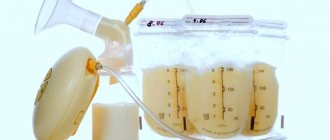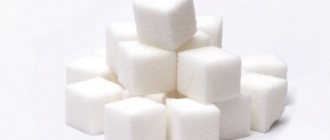The occurrence of allergies can be influenced by the mother's diet
There is nothing healthier for newborn babies than mother's milk. From this diet, the baby receives the necessary vitamins, trace elements and minerals that allow him to grow and develop. But sometimes after breastfeeding, mothers notice that the baby becomes lethargic and refuses to breastfeed. At the same time, symptoms characteristic of an allergic reaction appear on the body. The first thing a woman suspects is an allergy to breast milk. However, it is believed that no such diagnosis exists. Therefore, the cause of negative changes in the child’s body must be sought in the mother’s diet. [contents]
Maternal nutrition during breastfeeding
The selection of products for the diet of a nursing mother should be gradual.
Immediately after starting breastfeeding, it is necessary to monitor the condition of the skin and visible mucous membranes of the baby, his breathing and general health. Despite the actively current and popularly discussed opinion about strict prohibitions and restrictions on the mother’s diet, this is nothing more than another “fairy tale”. A huge selection of food products is available to feed the mother, and not entail pathological phenomena in the baby.
But it is not recommended to conduct overly exotic and daring experiments in the nutrition of a nursing mother. Naturally, the list of these experiments includes the consumption of the most well-known allergens, such as strawberries and other red sweet berries, oranges, lemons, tangerines, chocolate, peanut butter, seafood and more.
In addition, human milk can change its taste, color and smell. This also negatively affects the child's nutrition. To avoid this, mommy should avoid overly salty, spicy, sour foods, and foods rich in pronounced phytoncides (onions and garlic).
Nutrients in some foods can cause digestive problems in infants. These include cabbage, beans, beans, peanuts, etc. Eating these foods can even lead to severe diarrhea.
Lipids increase the density of mother's milk. The child, in turn, finds it very difficult to suck high-density milk, and it is almost impossible to express such milk. Therefore, a woman should limit the consumption of large amounts of fatty foods, namely sour cream, butter, cakes with creams, fatty meats, etc.
But fish oil, rich in omega-3 and omega-6 fatty acids and vegetable oils, should definitely be included in the diet.
Mommy should not forget about fresh seasonal fruits typical of her place of residence and non-starchy vegetables.
You should consume less processed foods, foods rich in preservatives, flavors and flavor enhancers. These additives will certainly harm the child’s body.
There is also an opinion among mothers that drinking plenty of milk increases the amount of milk. But scientists have not been able to prove the validity of this theory.
However, nursing mothers should maintain an optimal drinking regime. Recommended for use:
- Sweet green or white weak tea;
- Uzvar with dried fruits;
- A small amount of freshly squeezed juices and fruit drinks;
- Pasteurized milk;
- Special decoctions and mixtures that increase lactation (for example, fennel decoction).
Symptoms of an allergy to mother's milk in an infant
An allergy to breast milk is quite a painful disease for a baby’s family. The disease causes serious damage to the baby’s health, but also has an adverse effect on the financial side of the issue. Often such children have to be transferred to special expensive hypoallergenic formulas.
The most common symptoms of “milky” dermatitis in babies:
- Rashes in the form of spots and blisters.
- Maceration, dryness and cracking of the skin.
- Weeping peeling and inflammation of certain areas of the skin.
- Diarrhea followed by constipation.
- Flatulence.
- Swelling of the face.
- Pastiness of the limbs.
- Moodiness.
- Breast refusal.
- Swelling of the nasal mucosa and impaired nasal breathing.
If a baby experiences at least one of all of the above symptoms, then this is a possible allergic reaction to milk.
First of all, you should contact a competent pediatrician to clarify the diagnosis and solve this problem.
Sometimes foods consumed by the mother can cause bloating and colic in the baby. This is also a reason for refusing to eat these products.
Problems that are mistakenly considered a sign of “wrong” milk
“Inappropriate” breast milk is sometimes spoken of when a child has a number of symptoms:
A mother may hear such a diagnosis after a simple examination, but remember that true intolerance to breast milk is diagnosed only after testing.
Jaundice of newborns
Yellowness of the baby's skin and whites of the eyes does not mean that breast milk is not suitable for the baby. The first month of a baby’s life is accompanied by the active breakdown of red blood cells - they supplied him with oxygen during intrauterine development. During the breakdown, bilirubin is formed - it gives a yellow tint to the skin of a newborn.
Normally, this condition goes away within 4-5 weeks. Causes of lingering jaundice:
- premature or difficult labor;
- multiple pregnancy;
- drug therapy during pregnancy;
- vaccination in the first days of life;
- taking antibiotics by a child;
- hypoxia;
- drug induction of labor.
If jaundice persists, you should consult a doctor to find out the cause. This symptom is accompanied by disorders of the pancreas, liver, and hormonal system. This can only be determined by analysis.
Regurgitation
Frequent regurgitation after eating frightens young mothers and suggests that milk is not suitable. But most often this happens because the baby simply swallows air while sucking in the milk. If he was very hungry and ate avidly, air would naturally enter the stomach.
How do allergens get into milk?
Allergens, like beneficial nutrients, freely pass through the epithelial barrier between the milk ducts and blood vessels. The severity and severity of symptoms depends on the amount of allergen consumed in food.
Sometimes there is an immediate response to the product, but in most cases the response is prolonged for several hours.
Based on this, in order to determine an undesirable product for a child, it is necessary, after introducing something new into the diet, to observe the child’s reaction for a couple of days and only then draw conclusions.
It is worth noting that the allergen “travels” with the bloodstream in the mother’s body for a long time until antibodies destroy it. It follows from this that interrupting feeding or immediately expressing milk is not an effective treatment method if the mother continues to feed the baby after a short period of time.
Diagnosis of the disease
Allergy to breast milk is a difficult disease to diagnose. There are many diseases of the newborn period accompanied by similar manifestations.
It is very important not only to diagnose breast milk allergy, but also to determine the source of the allergens.
Diagnostics is carried out using:
- A survey of the child's mother and father about the nature of the mother's diet, complementary foods, animals and flowering plants at home.
- Questioning the mother in detail about her diet over the past few days.
- Physical examination and inspection of the crumbs.
- Blood test for Ig E titer.
- Blood test for the number of eosinophils.
- Ultrasound OBP.
To verify the diagnosis, a specific study of blood serum is carried out to determine its interaction with specific immunoglobulins E.
Skin tests are not used in infants.
Doctor Komarovsky about the problem
For adults, lactase deficiency is not a problem, says Evgeny Komarovsky. Nothing bad will happen if a person simply does not eat dairy products. However, for babies, for whom milk is the mainstay of nutrition, things are a little more complicated.
A decrease in lactase levels may be genetically determined, says Evgeny Komarovsky. If mom or dad cannot tolerate milk or did not like milk in childhood, then the likelihood of having a baby with lactase deficiency is quite high.
In all other cases, it was not without the influence of pharmaceutical magnates, who really need to sell large volumes of lactose-free milk formulas for artificial feeding. They cost much more than other food, but parents, who are put in a hopeless situation, are ready to pay whatever they want so that the baby lives and develops normally.
In premature babies, a lack of lactase can be explained by the immaturity of the body; they often experience transient deficiency. It goes away on its own as organs and systems mature. Depending on the severity, the disease can be complete or partial.
To dispel doubts or confirm the diagnosis, which has become so popular recently, various additional diagnostic methods are used:
- determination of stool acidity level;
- analysis for carbohydrate content;
- dietary tests.
During tests, under the supervision of a doctor, adapted mixtures are temporarily discontinued.
The child is given only lactose-free or soy formula for 2-3 days. When clinical manifestations decrease, a diagnosis of lactase deficiency is made.
In all cases (except for severe congenital ones, which, as already mentioned, occur only in 0.1% of cases), lactase deficiency is purely temporary.
The most common cause of milk sugar intolerance in children is banal overfeeding. Parents try so hard to feed their child that they give him an amount of formula or milk that exceeds all imaginable norms. As a result, a child whose enzymes are normal is diagnosed with lactase deficiency only because his little body cannot break down such a large amount of milk sugar.
For babies who suckle at the breast, it is much more difficult to give milk. Sometimes mothers and fathers do not understand what exactly the child wants. The child is thirsty and screams, but they give him food, believing that the baby is hungry. This can also lead to transient lactase deficiency.
Treatment according to Komarovsky
Temporary (transient) deficiency of the lactase enzyme does not require treatment, says Komarovsky. The production of the enzyme in the required quantity will be restored immediately after the cause of the disorder is eliminated (the baby will no longer be overfed and will begin to follow a drinking regime).
In case of secondary lactase deficiency caused by intestinal viral infections, the child is prescribed special medications. It is advisable to limit food intake and reduce its volume. Sometimes it is appropriate to start giving your baby probiotics.
A child with a genetically determined lactase deficiency is given lactose-free formula for up to six months, and then carefully and gradually begins to introduce dairy products into the diet.
Advice from Dr. Komarovsky
A nursing mother should not sound the alarm when she sees greenish liquid stool with a sour odor. This is a reason to contact a pediatrician, but not a reason to wean the baby from the breast. Moms shouldn't start making fun of themselves. The idea that mother's diet affects the lactose content in milk is nothing more than a myth. Breast milk always contains the same amount of lactose, which does not depend on a woman’s gastronomic preferences, time of day or frequency of feedings.
- To prevent the artificial one from overeating, you need to give him the mixture from a bottle with a small hole. The harder it is for him to suck, the faster he will feel full. The less likely he is to eat too much.
- When planning to reduce the amount of lactose in food, you need to find out which foods contain the most lactose. The undisputed leader in the percentage of lactose is human breast milk (7%), while cow and goat milk sugar contains approximately equal amounts (4.6% and 4.5%, respectively). The lactose content in mare and donkey milk is almost the same as in women's milk - 6.4%.
- If you are thinking about purchasing a lactose-free formula, you should first try giving your child low-lactose “Nutrilon” and the same “Nutrilak”.
Dr. Komarovsky will tell you more about lactase deficiency in the video below.
Is it possible, in theory, to have an allergy to breast milk without triggering factors?
This question concerns almost all mothers who are faced with allergies in their child. Of course, allergy to breast milk associated with maternal foods is more common.
But there are times when a baby’s reaction occurs specifically to milk or its components. A striking representative of such a disease is a severe genetic disease - galactosemia.
Children with this pathology lack a specific enzyme responsible for the breakdown of galactose. Children with this disease must be urgently transferred to special therapeutic artificial feeding immediately after diagnosis. Otherwise, galactose supplied with mother's milk is deposited in the central nervous system, liver, and eye tissues and leads to severe impairment of their function.
Galactosemia can hardly be called an allergy; rather, it is an intolerance to milk in any form. Another serious condition is lactose allergy or intolerance.
Although people call it “lactose allergy,” it is still a disease associated with the absence of the lactase enzyme. Lactase deficiency is characterized by gastrointestinal disorders.
Tests for lactase deficiency
There are several tests that can confirm lactase deficiency to one degree or another. Unfortunately, among them there is no ideal analysis that would guarantee the correct diagnosis, and at the same time be simple and non-traumatic for the child. First, we list the possible analysis methods [].
- The most reliable way to confirm LN is a biopsy of the small intestine. In this case, by taking several samples, it is possible to determine the degree of lactase activity based on the state of the intestinal surface. The method is used very rarely for obvious reasons (anesthesia, penetration of the device into the child’s intestines, etc.).
- Lactose curve. A portion of lactose is given on an empty stomach, and a blood test is done several times within an hour. Ideally, you would do a similar test with glucose as well and compare the two curves. To simplify the analysis, a test is done only with lactose and a comparison is made with the average glucose values []. Based on the results, one can judge LN (if the curve with lactose is located below the curve with glucose, there is insufficient breakdown of lactose, i.e. LN). Again, the test is more difficult to apply to infants - it is necessary to give lactose on an empty stomach, eat nothing but it, and take several blood tests. In addition, in the case of LN, lactose causes unpleasant symptoms, pain, gas formation, and diarrhea, which also speaks against this test. Foreign sources express certain doubts about the effectiveness of this test, due to the possibility of false positive and false negative results []. Nevertheless, the information content of the lactose curve is usually higher than the information content of the stool analysis for carbohydrates (in case of doubt, it is possible to use several of the listed methods for a more accurate diagnosis).
- Hydrogen test. The hydrogen content in exhaled air is determined after the patient is given lactose. The obvious disadvantage is that, again, when taking lactose, a whole range of unpleasant symptoms appear. Another disadvantage is the high cost of the equipment. In addition, in children under 3 months of age who do not have LI, the hydrogen content is similar to its content in adults with LI, and norms for young children have not been determined [].
- The most popular method is stool analysis for carbohydrates. Unfortunately, it is also the least reliable. The norms of carbohydrates in feces have not yet been determined. Currently, it is believed that the carbohydrate content should not exceed 0.25%, but scientists from the Institute. Gabrichevsky suggest revising the norms for carbohydrate content in the feces of a breastfed child (up to 1 month - 1%; 1-2 months - 0.8%; 2-4 months - 0.6%; 4-6 months. -0.45%, over 6 months - accepted and now 0.25%) []. In addition, the method does not answer which carbohydrates are found in the child’s stool - lactose, glucose, galactose, so the method cannot provide a clear guarantee that lactase deficiency occurs. The results of this analysis can only be interpreted in conjunction with the results of other tests (for example, coprogram) and the clinical picture.
- Coprogram analysis. Usually used in combination with other diagnostic methods. Normal stool acidity (pH) is 5.5 and higher; with FN, the stool is more acidic, for example, pH = 4. Information about the content of fatty acids is also used (the more of them, the greater the likelihood of FN).
Products that most often cause allergic reactions in babies
These products include:
- Whole milk, no matter how surprising it may be, but cow's milk proteins have the most aggressive effect on the child's body.
- Chicken meat and eggs.
- Seafood (shrimp, lobster, lobster, octopus, some types of fish, squid, mussels, oysters).
- Soy and products high in soy content.
- Gluten grains.
- Nuts, beans.
- Honey, pollen, beebread.
- Fruits and vegetables are red.
- Citrus.
- Fruits not typical for this geolocation.
- Flavor enhancers, flavorings, dyes.
When verifying the diagnosis, namely when identifying a specific allergen, it should be excluded from the mother’s diet for a month. Signs of a milk allergy then begin to subside by the end of the week after stopping the consumption of allergens in food.
After a month, it is permissible to try the “dubious” product again. If manifestations occur again, eliminate the product once and for all. And, importantly, do not introduce this product into complementary foods.











